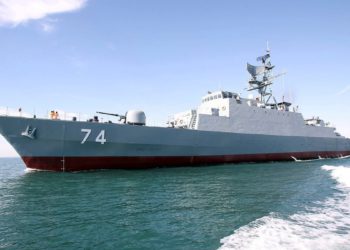Recently there has been much discussion about the U.S Marine Corps decision to shed their Abrams tanks and streamline their units for future operations. The decision was based off of a strategy that will require the Corps to be lighting fast, mobile and organized to conduct amphibious operations. These operations will be required to quickly establish strong points that deny potential enemies the freedom to operate naval and aerial forces within a predetermined area. This concept also supports a new maritime conop taking root.
Expeditionary Advanced Base Operations, or EABO, is the Marine Corps augmentation to the new naval operating concept known as Distributed Maritime Operations, or DMO. At the center of the Marine’s new concept is the plan to rapidly deploy, seize and retain critical key terrain in and around the maritime domains and then establish a strong point that complicates and restricts the movement of enemy forces. The goal, once done, will be to present a layered, anti-access strategy that presents tactical problem sets and reduces options for any potential enemy. Unlike other examples and variations of EABO, the Corps vision for operations are centered on modular and flexible units, that can move about the area and operate in unison with maritime and aerial forces, presenting a layered and complementary force, as opposed to standing alone and static functions.
What still needs to be defined is the exact capabilities that will be used to achieve the operational vision. It can be envisioned that long range air defense, long range strike missiles and long range radars will all need to be procured in order for this operational strategy to bear fruit. Luckily, the required elements are all either in service or in the final stages of development now and can be readily employed, that is until other future weapons are procured. Further, Marine units conducting EABO are also expected to be used in conjunction with other elements and can provide humanitarian support on short notice. This concept also implies that the Marines may have a form of Cooperative Engagement Capability (CEC) and maybe even the Naval Integrated Fire Control Counter Air (NIFC-CA). If so, having an organic capability to detect, target and engage aerial and surface threats, in conjunction with distributed naval units, will present a unique and comprehensive tactical problem for any adversary attempting to operate within a geographical location.

The Marine’s ability to rapidly employ vertically and operate forward in remote and austere environments will greatly enhance their abilities to interdict sea lanes of communication and project power, thus deterrence Further, as their Lighting carrier concepts evolve, possibly to include augmentation from other services, the Corps ability to shape and influence the maritime domain are about to get more significantly more robust. These capabilities are starting to be realized and in future budgets, it is likely that they will only further refine the concept.
Below is a graphical representation of the EABO operating concept, with conceptual ranges of potential weapons. What is important to note and take away is that the locations are merely suggestive as to where an EABO can occur. As long as there is room for a few vehicles, armed with either air defense missiles and or long range strike missiles, there is enough room for a strong point, as the intent is to have a rapidly established position that can disperse or move in short order. As technology advances, it is not outside the realm of possibility that future elements will become unmanned and or merely floating barges, filled with VLS cells, protected by a ground defense element.










